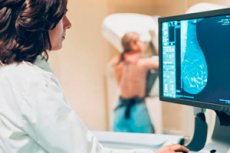Fatty underarm nodes on a mammogram may signal a risk of cardiovascular disease
Last reviewed: 14.06.2024

All iLive content is medically reviewed or fact checked to ensure as much factual accuracy as possible.
We have strict sourcing guidelines and only link to reputable media sites, academic research institutions and, whenever possible, medically peer reviewed studies. Note that the numbers in parentheses ([1], [2], etc.) are clickable links to these studies.
If you feel that any of our content is inaccurate, out-of-date, or otherwise questionable, please select it and press Ctrl + Enter.

Faty enlarged axillary lymph nodes on screening mammograms may predict the risk of cardiovascular disease (CVD), according to research presented at the annual meeting of the American Radiological Society (ARRS). Which took place from May 5 to 9 in Boston.
Jessica Rubino, MD, of Darmouth-Hitchcock Medical Center in Lebanon, New Hampshire, and her colleagues used electronic health records data from 907 women (ages 40 to 75 years) without known coronary heart disease who underwent routine screening mammography and who had cardiovascular disease risk factors available within one year of the index mammogram (2011-2012).
Researchers found that 19.1% of women had fatty enlarged nodes (>20 mm in length due to an enlarged fatty sinus). Women with fatty nodules had a high risk of CVD as determined by the pooled cohort equation (>7.5% odds of major adverse cardiovascular events [MACE] at 10 years; odds ratio [OR] 2.6; 95% confidence interval [CI] 1.5 to 4.2), as well as a higher prevalencetype 2 diabetes (OR 4.0; 95% CI 2.1 to 7, 7) and hypertension (OR 2.5; 95% CI 1.6 to 4.0).
There was also an association between fatty nodules and a trend towards a higher risk of MACE (OR 1.7; 95% CI 0.9 to 3.1) and low-density lipoprotein cholesterol (OR 1.4; 95% CI 0.9 to 2.1).
“Integrating fatty nodules into CVD risk models has the potential to improve CVD risk stratification without additional costs or additional testing,” Rubino said in a statement.
“Faty, enlarged axillary lymph nodes visualized on screening mammography may improve the ability to identify women who might benefit from CVD risk reduction strategies and more intensive risk assessment using coronary computed tomography.”
